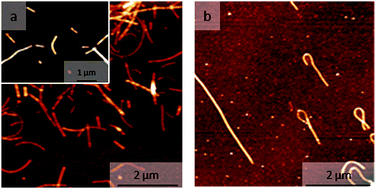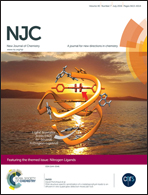In situ functionalization of self-assembled dendrimer nanofibers with cadmium sulfide quantum dots through simple ionic-substitution†
Abstract
Cadmium sulfide quantum dots (CdS-QDs) can be generated along poly(propylene imine) (PPI) dendrimer-based self-assembled nanofibers through a simple approach based on ionic substitution. Supramolecular nanofibers are obtained via self-assembly of cationic PPI dendrimers in aqueous solution containing cadmium acetate. The dissociated asymmetric acetate ions (AcO−) are the “glue” for the self-assembly process. The semiconductive CdS nanoparticles are synthesized at room temperature along the self-assembled nanofibers by the addition of sodium sulphide (Na2S) in solution. Molecular dynamics (MD) simulation shows that the higher affinity of SH− ions (from dissociated Na2S) for Cd2+, compared to that of AcO−, triggers ionic substitution at the interface between the dendrimers. TEM and AFM measurements confirm the self-assembly of the fibers and the formation of CdS quantum dots along the filaments having a final size of ∼2 nanometers. The obtained absorbance results show the presence of quantum confinement effect. Since these self-assembled fibers can be disassembled by a simple addition of sodium chloride in solution (ionic competition), this work proposes a new facile route to obtain functional materials in a convenient way.


 Please wait while we load your content...
Please wait while we load your content...